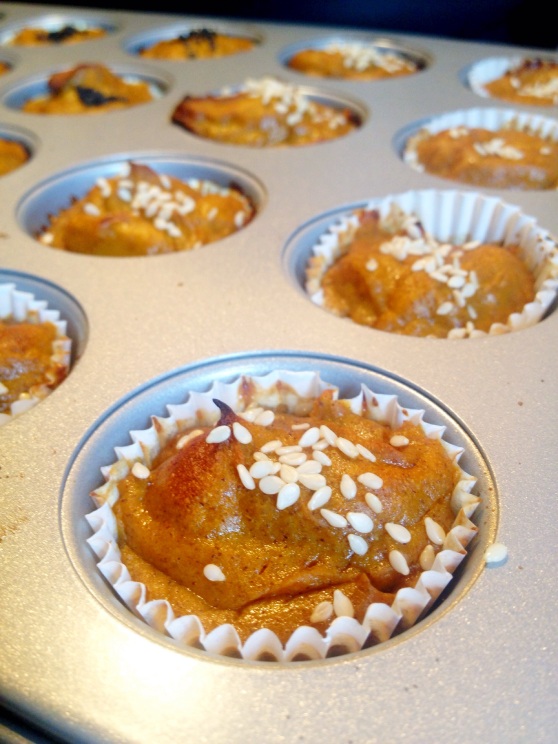An old friend of mine from my high school days in Japan asked me today if I could take an old and familiar Japanese dessert and make it healthier and plant-based. The dessert is what the Japanese call simply “sweet potato” or “su-i-to-po-te-to”, to be precise. It’s a sweet and savory dessert that is full of sugar and butter, and tastes so good! While trying to find examples of this dessert to show you, I stumbled upon this hilarious Japanese cooking demo for the dessert where this lady cooks with her poodle (not literally cooks her dog, but you know what I mean). You can watch it here:
I wish I had found this video earlier because I definitely would have added rum to my recipe when I was trying to make it! Anyway, I had two slightly different recipes my friend and I found and I decided to make both. I used a recipe from Hungry Note for version 1 and a recipe from Kyoto Foodie for version 2. In order to make them plant-based, I would need to make substitutions for the egg yolk, butter, milk, and cream. After much research (i.e. googling), I decided I would use silken tofu, avocado, coconut milk and coconut “cream” as my replacers, in that order.
One thing I was a little uncertain of was how the texture and taste would differ since I wouldn’t be using Japanese sweet potatoes. I can’t find those locally here so I used the regular orange flesh “yams” that I found at the farmer’s market. Japanese sweet potato, or satsumaimo, has a purplish peel and light yellow flesh. It’s a little sweeter than what we call a sweet potato in the States. I found a great article in the Japan Times written by the author of one of my favorite Japanese blogs, Just Hungry, that talks about the history and uses of satsumaimo.
The verdict — both versions of the sweet potato cakes were very good, taste-wise. Not too sweet, a little caramelized on top, and very creamy. Texture-wise, they were definitely too soft. It was a little softer than sweet potato pie filling, and while it did firm up a bit as it cooled, I still think it lacks the traditional texture. Next time, I will probably keep all the ingredients the same but increase the amount of sweet potato. I would definitely add at least one extra sweet potato, maybe even two. I think that would give it the more potato-y texture that is missing. However, this recipe as it stands has really great flavor, both cooked and uncooked. I could eat it raw as a sweet potato pudding as well. And it’s pretty healthy as far as desserts go, so you could use it as a side with your dinner, or even for breakfast if you wanted. I also think it would make a really great pie filling. I might experiment with baking one of these versions in a pie for Thanksgiving this year. I can’t vouch for how close it is to the original since it’s been over 15 years since I’ve eaten suitopoteto, but since I really enjoyed the flavor, I would definitely not call this experiment a failure!
japanese sweet potato cakes “suito poteto”, version 1
ingredients
- 2 medium sweet potatoes, peeled
- 1/4 cup coconut “cream” (place can of coconut milk in fridge for 15-20 min. Use the thickened “cream” off the top of the can)
- 1/4 cup maple syrup
- 1/2 ripe avocado
- 1/8 cup silken tofu
- 1/4 tsp vanilla extract
directions
- Preheat the oven to 425˚F. Bring a medium-sized pot of water to boil on the stove top.
- Cut the peeled sweet potatoes in 1/4-inch rounds and then halve and quarter them. Boil for 4-5 minutes until fork tender.
- Drain the sweet potatoes and return to the pot. Mash them in the pot over low heat to evaporate a bit of the moisture.
- Add the avocado, tofu, and maple syrup to the pot and blend with the potatoes using an immersion blender. (Can also spoon into a food processor or blender)
- Gradually add the coconut cream and blend until smooth. Add the vanilla extract.
- Line a baking tray with parchment paper or foil. Spoon the mixture onto the tray in any shape you want. If it’s too runny, you can use line a muffin tray and use that instead. Mine made 9 little cakes.
- Brush the tops with a bit coconut cream.
- Bake for 20-30 minutes until set and golden brown. Place tray on a cooling rack for 10 minutes. Place a sheet of wax paper on top of cooling rack and use a spatula to place the cakes on the paper. Cool for another 20-30 minutes. They will firm up more as they cool. Enjoy!
*Notes: Next time, besides increasing the amount of sweet potato, I will also try the following: mash the sweet potatoes by hand, blend everything else in a blender or food processor, then stir the mixture into the hand-mashed sweet potatoes. That may help solve the texture problem and make it less runny.
japanese sweet potato cakes “suito poteto”, version 2 “kyoto-style”
ingredients
- 2 sweet potatoes, peeled
- 1/4 cup maple syrup
- 1/2 avocado
- 3 tbsp coconut milk (may substitute other non-dairy milk)
- 1/4 cup silken tofu
- 1 tsp cinnamon
- pinch of salt, optional
- sesame seeds
directions
- Preheat oven to 425˚F.
- Cut the sweet potatoes into 1/4-inch rounds and halve and quarter them. Steam for 10-20 minutes until fork tender.
- Place in a bowl and add the maple syrup and avocado and begin mashing.
- Add in the coconut milk, tofu, cinnamon, and salt.
- Form into balls and place onto a lined baking sheet, or spoon into a lined mini-muffin tray as I did.
- Top with white or black sesame seeds and bake for 20-30 minutes until set and golden brown on top.
- Cool in muffin tray or on baking sheet for 10 minutes before removing. Allow to cool for 10 minutes more on a wire rack. They will firm up a bit as they cool. Enjoy!
*Notes: Next time, besides increasing the amount of sweet potato, I will also try the following: mash the sweet potatoes by hand, blend everything else in a blender or food processor, then stir the mixture into the hand-mashed sweet potatoes. That may help solve the texture problem and make it less runny.





